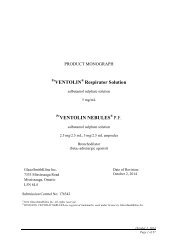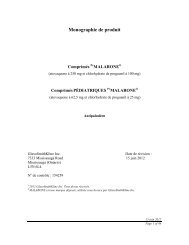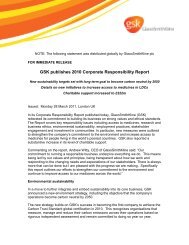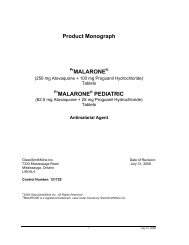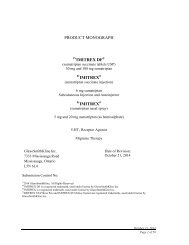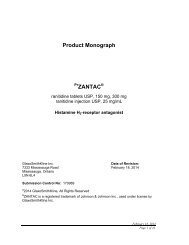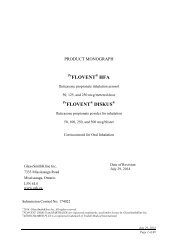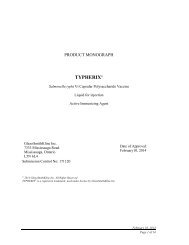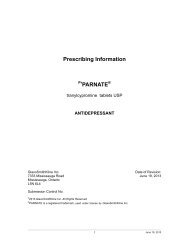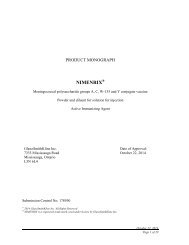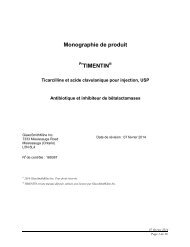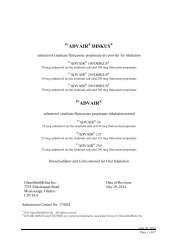VENTOLIN I.V. infusion solution - GlaxoSmithKline
VENTOLIN I.V. infusion solution - GlaxoSmithKline
VENTOLIN I.V. infusion solution - GlaxoSmithKline
Create successful ePaper yourself
Turn your PDF publications into a flip-book with our unique Google optimized e-Paper software.
DETAILED PHARMACOLOGY<br />
Animal<br />
Salbutamol exerts a relatively selective action on the beta 2 -adrenergic receptors of the<br />
bronchial and vascular smooth muscles. In anesthetized guinea pigs, salbutamol<br />
completely prevents acetylcholine-induced bronchospasm at the dose of 100 mcg/kg<br />
intravenously.<br />
In anesthetized dogs, salbutamol is one-fifth as potent as isoprenaline in skeletal muscle<br />
vasodilation.<br />
In the isolated atrium preparation of guinea pigs, salbutamol was 500 and 2500 times less<br />
potent than isoprenaline in increasing the rate and force of contraction, respectively.<br />
Administration of salbutamol aerosol at the dose of 250 mcg/mL for one minute to guinea<br />
pigs, prevented acetylocholine-induced bronchospasm without any effect on the heart<br />
rate.<br />
In anesthetized cats and dogs, salbutamol prevented the bronchospasm elicited by vagal<br />
stimulation, without any significant effect on heart rate and blood pressure. Comparative<br />
tests of salbutamol and isoprenaline in isolated dog papillary muscle, guinea pig atrial<br />
muscle and human heart muscle, have shown that the effect of salbutamol on betaadrenergic<br />
receptors in the heart is minimal.<br />
In 6 dogs with right-sided cardiac bypass, salbutamol, given at the dose of 25 mcg/mL,<br />
improved left ventricular efficiency and increased coronary blood flow.<br />
Recent studies in laboratory animals (minipigs, rodents and dogs) recorded the<br />
occurrence of cardiac arrhythmias and sudden deaths (with histologic evidence of<br />
myocardial necrosis) when beta-agonists and methylxanthines were administered<br />
concurrently. The significance of these findings when applied to humans is currently<br />
unknown.<br />
Human<br />
Intravenous salbutamol had approximately one-tenth the positive chronotropic potency of<br />
intravenous isoprenaline.<br />
Salbutamol and isoprenaline were equipotent bronchodilators when given intravenously.<br />
However, 7 times the <strong>infusion</strong> rate of salbutamol was necessary to increase the heart rate<br />
by the same amount as with isoprenaline.<br />
Intravenous salbutamol increased ventilatory response to inhaled CO 2 in both hypoxia<br />
and hyperoxia. There was an increase in heart rate which was most pronounced when<br />
hypoxia was combined with hypercapnia. Plasma potassium was decreased in<br />
association with an increase in plasma glucose and serum insulin.<br />
October 03, 2007<br />
Page 12 of 21



